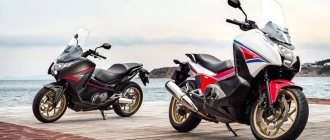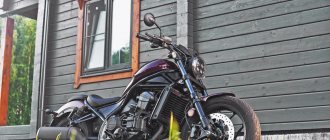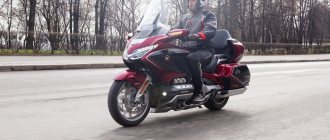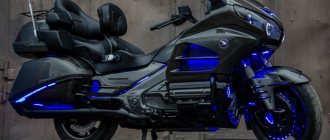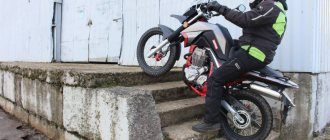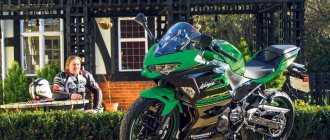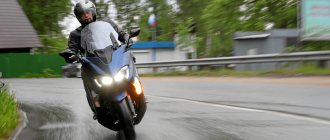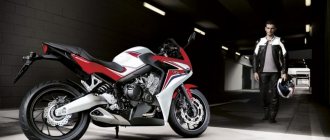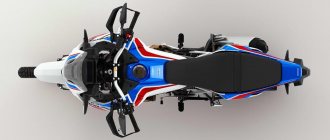13K 6 min.
Is it really possible to buy a new crossover with an automatic transmission, and from a respected Japanese brand, for less than half a million rubles? Don't even argue - it's absolutely real. True, it will not be a car, but a motorcycle.
Previous photo
Many motorcyclists, contrary to traffic rules, use high beam headlights during the day to be more visible.
Photo: Kommersant / Dmitry Lebedev / buy photo
Although the windshield is tiny, the effect of its presence is clearly noticeable, especially at high speeds
Photo: Kommersant / Dmitry Lebedev / buy photo
Carrying luggage options on a motorcycle are limited, but special accessories can go a long way toward solving this problem.
Photo: Kommersant / Dmitry Lebedev / buy photo
Next photo
1 / 3
Many motorcyclists, contrary to traffic rules, use high beam headlights during the day to be more visible.
Photo: Kommersant / Dmitry Lebedev / buy photo
Although the windshield is tiny, the effect of its presence is clearly noticeable, especially at high speeds
Photo: Kommersant / Dmitry Lebedev / buy photo
Carrying luggage options on a motorcycle are limited, but special accessories can go a long way toward solving this problem.
Photo: Kommersant / Dmitry Lebedev / buy photo
VASILY OSTROVSKY
About the diversity of species
In the world of motorcycles, the same processes are now seething as in the automobile market - the active mixing of different classes and the development of newly formed niches. The traditional classification is bursting at the seams, unable to cope with the influx of new models that do not fit into the existing canons. For example, crossovers are a relatively new genre for the two-wheeled industry. As you might guess, a crossover should be understood as a purely highway vehicle, which is endowed with some features characteristic of off-road vehicles. The Honda NC750XD readily fits into this format: it is stylized as a serious touring enduro (the beak under the headlight alone is worth it), moreover, compared to ordinary asphalt motorcycles, it has a slightly increased ground clearance and slightly longer-travel suspensions. In general, the appropriate surroundings are present, and no one demands more from an SUV.
Apparently, the development of the NC family of motorcycles (in addition to the NC750XD crossover, it includes the NC750S naked bike and the Integra maxi-scooter) was initiated more by marketers than by engineers. It turns out that a sociological study was conducted and it turned out that 90% of owners of medium-sized vehicles do not risk accelerating faster than 140 km/h and, moreover, do not like to spin the engine above 6000 rpm. This means they need, how can I put it, a more “automotive” motorcycle. Okay, no problem - everyone can do it at Honda.
Decent ground clearance allows you not to be too careful when driving on curbs
Photo: Dmitry Lebedev, Kommersant
The two-cylinder engine, designed specifically for NC, is truly similar in characteristics to a car. By motorcycle standards, it turned out to be low-boosted: 745 cc were given only 54 horsepower. For comparison: 600 cc sportbikes have long crossed the hundred horsepower mark. But the new engine has smooth traction throughout the entire rev range, while the “sports” only begin their life at the eight thousandth mark on the tachometer - where the NC750XD’s red zone already ends.
The most interesting thing is that this engine doesn’t just look like a car’s – it actually is a car’s! This is “half” of the power unit from the Honda Jazz hatchback - the engines are unified according to the cylinder-piston group. The engine is installed with a fair inclination forward, thanks to which the center of gravity is quite low, even despite the general “elevation” of the motorcycle above the ground. And this is good: you can safely count on decent maneuverability and decent handling.
By the way, the bike is similar to a four-wheeled vehicle not only in the origin of the engine, but also in a number of other features: combined brakes with an anti-lock braking system, the presence of a lockable trunk and an automatic transmission. Actually, it was the operation of the transmission that became the most interesting item on the driving menu for me.
Engineers have been making attempts to save the rider from manipulating the gearbox for more than half a century. For example, in 1952, Ducati launched the Cruiser 175 scooter, which was equipped with a torque converter automatic transmission. This model was not particularly popular: the public was distrustful of such an advanced technology. In the mid-70s, the Italians and Japanese introduced motorcycles with automatic transmissions almost simultaneously, but the Moto Guzzi V1000 Convert and Honda CB750A Hondamatic were still too imperfect to conquer the market. With the advent of the new century, experiments continued: in 2003, the Italian company Gilera released the Ferro 850 concept bike, which formed the basis for the Aprilia Mana 850 production model, where the transmission of torque to the rear wheel was controlled by a variator. And only after that Honda perked up, taking the situation into its own hands: in 2008, the Japanese created a futuristic cruiser DN-01 with an ingenious hydrostatic transmission, and a couple of years later the VFR1200FD sports tourer appeared, equipped with a preselective DCT (Dual Clutch Transmission) robot with two clutches . This is exactly the same box, only of the second generation, found on the NC750XD.
On the Russian Honda website, you should look for the NC750XB among the enduro, although in fact it is a purely road motorcycle
Photo: Dmitry Lebedev, Kommersant
Moto, but not that
Even though I have decent experience riding a scooter, my experience with DCT caused cognitive dissonance. Starting the engine was not difficult: the process is the same as on a regular motorcycle. But then the struggle between skills and reality began. The first thing I did was grab the non-existent clutch handle, moving my fingers through the air, but I quickly realized that such passes would lead to nothing. Like on a scooter, you won’t be able to move either: there is no centrifugal clutch, which is activated when you add gas - you have to get out of neutral using the button on the right remote control. By pressing the key with the letter D, I turned off the engine because I forgot to remove the kickstand.
Okay, let's try again.
Step - starter - drive. Something clicked near his right leg, but the motorcycle did not move. I carefully move the throttle and the crossover starts moving. Ugh!
At first I don’t drive fast - I listen to the sensations. The robot changes gears very smoothly and almost imperceptibly - this can be guessed only by the sound of the engine. The sound, by the way, is cool: not too loud and not particularly expressive - just that, cool. It’s as if someone is quickly knocking small hammers on a tiny anvil.
The robot tries its best, moving to higher and higher levels, and now at a speed of 60 km/h the Honda is driving in the highest sixth gear. What if you speed up the pace? Not bad! The acceleration dynamics seem very convincing: it is clear that 54 horsepower does not promise madness, but I still expected the worst.
If a Bluetooth headset is installed on the helmet, it will have to be removed before placing the “head” in the “toilet”
Photo: Dmitry Lebedev, Kommersant
I liked the way the NC750XD took off from a standstill. At the first traffic light, after waiting for the green signal, I boldly twisted the gas and almost let the motorcycle go free: the clutch engages quite sharply, and the Honda literally jumps forward. This came as a surprise to me, but it served as a good lesson: from now on I started more carefully, and later I adapted and always left the traffic light first - the low-torque in-line “two” contributes to this in every possible way.
True, after driving to work in traffic jams, I slightly tempered my enthusiasm for the DCT. Firstly, when moving between the rows, it is impossible to indicate your presence by changing the gas: you will immediately fly away somewhere. Secondly, the sharply activated clutch forces you to handle the throttle extremely delicately when driving at ultra-low speed, and active use of the rear brake does not save the situation. Thirdly, the robot still does not understand that it is impossible to switch in turns. In the “Drive” mode there are no special problems: the engine operates at extremely low speeds, and the likelihood of the rear wheel slipping is minimal. But in “Sport” the chances of “losing your butt” increase - the engine revs up more actively and shifts occur more abruptly. You can, of course, turn to manual mode... But then why do you need an automatic machine at all?
And yet the box works great - noticeably better than the well-known DSG robot on Volkswagen cars. The most important thing here is to figure out whether a motorcycle with an automatic transmission is needed in principle. If you need it, then there is no alternative to Honda: DCT seems to be the best implementation of an automatic transmission on two-wheeled vehicles, even despite the ubiquity of the CVT.
Still, I would prefer a bike with conventional mechanics, it’s more familiar to me. But I won’t dissuade anyone from the NC750XD. But I’m ready to campaign for him: everything was done too smoothly.
Preselective dual-clutch transmissions can be found on various Honda models
Photo: Dmitry Lebedev, Kommersant
Another argument in favor of our motorcycle is the presence of a lockable trunk. Scooter riders will not be surprised by the presence of a trunk: in any scooter under the seat you can find a so-called toilet - a fairly spacious container for storing various items like a helmet for the second number. The NC family of motorcycles also have a similar cargo compartment, only it is located not under the saddle, but in a much more unexpected place - where the gas tank is located on regular bikes. The storage compartment capacity is 21 liters - this is quite enough to accommodate an integral helmet. I was able to experiment with different models, and I found out that this “glove compartment” is not hospitable to every “cap”. Let's say, a helmet size XS fits into a Honda without any problems, an Emka fits in less confidently, and the largest hats, sizes L and XL, turned out to be too big.
Nevertheless, having a trunk is a great joy for a rider; in two weeks of communicating with a motorcycle, I gave up using my beloved backpack, overcame my fear of stores, and even took a gift to a friend in Noginsk, which I visit extremely rarely due to the great traffic jams in Balashikha. In general, switching from a Honda to a motorcycle without a trunk turned out to be difficult.
Of course, from the point of view of a “proper” biker, a motorcycle with a “toilet” and a robotic gearbox does not look serious. However, if you extinguish your stereotypes, the picture immediately changes, and a bike with an automatic transmission and a spacious trunk appears as a surprisingly practical thing.
Test drive Honda NC750X (2021): An exemplary city dweller
Finally, the very days have come when you have to drive, drive, ride, in order to have time, time, time, time to try as many different motorcycles as possible - and tell something informative about them. What if it comes in handy? We continue our long-term (almost 10 years old!) saga about the Honda NC: this time, about the NC750X - so is it a crossover, an enduro, or just a cool motorcycle for every day?
MOTOGONKI.RU, June 13, 2021 — Do you often have to drive off the asphalt? Just a couple of years ago, the answer would probably have been obvious: why? But today, given the closed borders, we choose other routes, and most of them began to pass through Russian territories, where road workers are not as motivated as in Moscow and the Moscow region. “Civilization” has reached my favorite test territories of all crossover and off-road vehicles - the Tver and Leningrad regions, and now there are gorgeous roads there, driving has become a bit boring - too fast and smooth, but they installed cameras... New interesting places were found in the Yaroslavl province - here, where this motorcycle should be in demand! The Honda NC750X was created for roads that no working person has set foot on for the last 10 years. However, I would not call the NC750X a “mini Africa Twin”. Let's go through why.
Honda NC750X (2021)
A little history of the NC750X
The motorcycle appeared in 2012. The idea was to create a budget station wagon with a modern design and equip it with a couple of unique features. The NC700X has become a good replacement for the second-hand items of the early 2000s - economical, unpretentious and very simple in everything. Such a feature as a trunk in place of a tank is absolutely brilliant! This will be discussed in more detail below. We received the very first Honda NC700X
at the very beginning of the summer of 2012 and tested it from scratch.
In 2014, the 2-cylinder in-line engine became fatter by 45 cc, and in order to finally capture the niche, the NC750X was equipped with a DCT automatic transmission - and now Honda has a super-versatile road bike with the ability to drive off the asphalt. In 2021 it was updated a little, then in 2021 a little more.
But it was the 2021 generation that became - exactly the way I would like to see this motorcycle: beautiful and much more suitable for driving on roads of “not the same quality” than the #YouZCrossover of 2021 - this one:
Test drive a 2021 Honda NC750X
More information about the previous generation - TyZhcrossover - test drive Honda NC750X (2017)
What does the plant focus on in the new model?
First of all, the NC750X now has a full-fledged contactless Throttle-by-wire throttle with modern “brains”, no worse than those in Africa. Not a multimedia and communications center, but only part of it - the driving package, which works in combination with DCT. And this set changes everything!
Honda NC750X - 2021 vs 2014 - dramatic changes in design
In addition to the fundamentally new design, which was worked on by the Italians from the Milan Design Bureau of Honda Motor Co., there is already a full LED chandelier, stops and turn signals. The motorcycle was “dressed” in more advanced plastic cladding to improve wind and weather protection.
Honda NC750X (2021) in Candy red
The chassis has been updated. First of all, the frame was made narrower, lighter and stiffer, and a new fork and Showa monoshock were installed (both units with 120 mm of travel). Well, the motorcycle has become 6 kg lighter overall, although this is not too noticeable in its weight distribution and balance - it was never heavy to the touch anyway.
What has actually improved?
Driving comfort has become much greater, and this is a fact. The shape of the seat is now completely new: it itself is 30 mm lower, and deeper, wider and softer, with better support for the buns. The seating triangle was revised back in 2021, and by 2021 it became simply optimal: after 3 hours in the saddle, I didn’t have the slightest sign of anything leaking at all!
Changes in the Honda NC750X in 2021, what do you pay attention to first?
The first thing you notice right away is the updated chassis and Showa Dual Bending Valve (SDBV) fork - they are now all-consuming. The main test of the NC750X was carried out on the longitudinal tracks of the high-speed M9 - zero attention! The behavior of the motorcycle on shallow ruts in the second row is as if there are no ruts at all. On deeper longitudinal bumps, from which cars on wide tires steer to the side, the NC750X drives straight - whether you want it along the track, whether you want it next to it, or whether you want it across it - no disturbing vibrations come into the steering wheel at all.
The new chassis jumps over speed bumps without hesitation; just open the throttle a little at the entrance to relieve the load on the front-end. Smooth bumps – they simply don’t exist for the new Showa.
Hard off-road is not an obstacle at all for the Honda NC750X
The situation is slightly different with potholes [on what was once an asphalt road] with steep and hard sides. The wheels on the NC750X are still alloy, and they do not “play” with the tire during serious frontal impacts on these beads, as would be the case with spokes on the Africa Twin. Unlike the CRF1100, the NC750X will not travel through “hard” holes with a depth of more than 5 cm - the fork may simply not work and you will hit the edge as if it were a barrier. You don't have to do that.
The 2021 NC750X rides confidently on dry ground, just keep your balance when crossing ruts with hard sides. Of course, Dunlop doesn’t even make any attempt to cling to the parapet (and there’s nothing there to cling to). But it crawled through shallow but loose sand without any complaints.
HSTC helps a lot on wet and loose soil. But you simply don’t need to get into completely liquid shit on standard tires, so as not to end up in an uncomfortable situation, as in 2021 with #YouZhcrossover...
Honda NC750X (2021) - what does a good city dweller do on weekends? is having fun!
Thanks to the completely unpredictable weather near Moscow, we were able to ride both on dry and completely water-filled asphalt, and even jump at good speed over water-filled ruts, this scourge of a motorcyclist.
Usually, when the rear wheel gets into a rut with water, inevitable aquaplaning occurs: a road tire, no matter how punchy it is, cannot squeeze the water out through the sipes and simply does not reach the asphalt. As a result, the rear of the motorcycle is thrown out of track and a fall occurs. This is not the case with the 2021 NC750X.
It's hard for me to say why. Perhaps the improved weight distribution 48/52 and the new frame rigidity played a role. Or maybe this is a feature of the Dunlop Trailmax D609 rear tire (160/60 - not very wide), but the wheel confidently breaks the rut and always holds the asphalt. These same Trailmax D609 were not received with enthusiasm in 2021, and most users quickly replaced them. But most likely, a combination of three components worked, where the main thing is the sensitive operation of HSTC in Rain mode
. HSTC catches the moment of failure in a split second and interrupts it. The behavior of a motorcycle is similar when driving through slippery wet patches on the highway.
With these brakes, the Nissin Honda NC750X stops dead in its tracks
The motorcycle brakes as it should, both on the ground and on the asphalt. The slipper clutch now does most of the work, allowing Honda to implement several different Engine Brake strategies. The front brake should only be applied in truly emergency situations when you need to slow down very quickly. The most aggressive engine braking is in Sport mode.
In general, I noticed very serious changes for the better compared to the previous generation in terms of driving.
New trend in motorcycle manufacturing
The NC750X motor has become a few ponies more powerful, and now its maximum is something like 59 hp. Of course, this is not a figure that makes an impression when it comes to a 745 cc engine.
But this has been the trend of the last 5-7 years in the industry - to increase the displacement, extremely depressing the engine for the sake of torque, but not power and peak speed.
The advantages of this approach:
peak torque is achieved at low speeds – available earlier, which is good;
the lower the speed, the lower the gasoline consumption; The lower the speed, the lower the noise level and CO emissions. More torque means both confidence in piloting and smoothness. The producers' idea is clear. The downside is purely psychological
: against the backdrop of the abundance of second-hand goods from Japan and Europe in the mid-2000s, the NC750X looks “dull,” which misleads the average consumer. The motorcycle seems “weaker” than it actually is.
What's the trick?
If you rode motorcycles before the year 2000, then you remember what the “standards” of those engines “with direct drive” throttle valves were: larger jets, louder pipes, so that there was also more power, and in general, more numbers on the speedometer and … fuck fuel economy! My garage has seen many motorcycles from 1987-2013, including new ones from the showroom. And none of them showed an average consumption below 7 l/100 km, even “four hundred”. The statistics are inexorable: the engine is 650-800 cc. I consumed 8 liters, and 900-1300 cc. – 9-10 l/100 km. And even if it cracks, the average will not be lower! When carburetors became a thing of the past, the situation changed dramatically. A motorcycle with an injector is more efficient: at the same distance, at the same average speed, it will consume less, giving the same performance - a more efficient mixture burns better and releases more energy! And you immediately travel 10% more kilometers, saving travel time and getting less tired. This is progress.
When sports technology with dynamic changes in fuel and power maps reached road and street motorcycles, a new revolution took place. And it fell on the period from 2014 to 2021.
Finally, by introducing DCT, Honda put the idea of optimizing the operation of the internal combustion engine at the forefront
Scheme of HSTC operation in Honda NC750X (2021)
The NC750X's set of driving modes includes three main ones + “custom”, in which you can create your own setup Engine Brake, Power and Traction Control (HSTC). The two main ones, Sport and Standard, differ in the level of power delivery (smooth opening and maximum opening angle of the throttle valves), control of rear wheel slip (stall) and aggressiveness of engine braking. In Sport mode, you only have to use the front brake for emergency braking – such is the powerful stopping effect of EB on this 2-cylinder engine!
It is worth noting that the difference between Sport and Standard is felt instantly
, it is enough to drive 10 km in each of them. Sport provides late DCT upshifts and downshifts, Standard upshifts, once you reach the point of “acceptable” torque - and now, at 58 km/h you are in 6th gear. This is the standard DCT strategy - reaching top gear in the shortest possible time to save fuel.
The peculiarity of the “standard” operation of DCT in this regard would be assessed negatively by many. Why?
Test drive Honda NC750X (2021)
The acceleration dynamics of the NC750X with DCT are sufficient for the city and country highways, but on a highway like M9 or M11, in the left lane you will not feel like a king: to accelerate from 120 to 160 km/h, you need to open the trigger and count to three. Overtaking lines of trucks is not easy. The task becomes more complicated if some Honda Accord with an engine of 2.4 liters or more is traveling in the same direction. In the standard mode of operation, the DCT NC750X simply does not have enough dynamics to “eat” both a truck and a frisky Honda in one sitting - you will be driving with it at the same pace. And when you finally reach 160 km/h, you will realize that there is no room to overtake. This is depressing, because on the highway you want a motorcycle with a 600+ engine to have more potential.
There is always a solution!
To solve the problem with agility, just switch from mode “A” (“automatic”) to mode “M” (“manual”) or simply “help” the gearbox with the gearshift paddles down: before starting the maneuver, drop down a couple of steps and rush forward. In this case, the dynamics when the engine is running from 4500 rpm. and higher is more than bearable, and the acceleration is noticeable. The motorcycle will accelerate very aggressively after the break-in is completed, that is, after 1000-1200 km on the odometer.
Manual kick-down with this button: minus 1-2 gears at a time - easy!
The peculiarity of the new DCT algorithms (in 2010-2012 they did not yet exist, but now they do!) is the possibility of such manual kick-downs, and the DCT program makes it possible to realize the speed potential: the box does not try to return the driver “to the true path”, but it allows him to drive enough time in the “uneconomical” mode, and only when the dynamics stabilize, he returns to the previous program. Driving at some even pace, like 140 km/h, is a pleasure: no vibrations, no unnecessary noise. I drove around the city at a pace of 50-70 km/h, and also – zero negative emotions, complete relaxation!
Sport vs Standard
Some people switch straight to Sport and never change the mode again - like, it’s not like a boy to ride otherwise... “real” motorcyclists should tear and throw! Good luck.
Honda NC750X (2021) dashboard - engine operating modes
However, each of the modes has its own real purpose. If on the highway the difference between Sport and Standard is immediately felt in terms of dynamics, then in terms of consumption it is even greater: per 100 km of driving in Sport mode you will immediately see consumption of 2-3 liters more! In the case of aggressive driving with constant overtaking (i.e. 30-40 km/h faster than the flow speed), the average consumption will increase to 6.5 l/100 km. In the “standard” it will not exceed 5.1-5.3 l/100 km, even if you constantly drive at a pace of 130-140 km/h. I drove around the M9, measuring average and instantaneous consumption at speeds slightly above 160, and saw that they were more realistic for an engine of this volume - 8 liters. But the average consumption per 100 km still did not exceed 5.8 liters over 950 km, which I managed to drive in a couple of days.
The whole question is how to drive. If you pull the trigger from 80 to 160 and back, it will be much higher due to the kick-down (dropping down a gear or two for sharp acceleration). With this “swing”, the revolutions immediately increase by 2500-3000 and reach about, where the control panel begins to wink with the economizer indicator - pink, turning into bright red. And if you immediately take the speed higher than the flow and just keep the accelerator open, the motorcycle rides at even rpm, say, 5000, and the consumption will be 1-2 liters lower in the moment.
Engine Honda NC750X (2021)
Anyone who drives along the Moscow Ring Road regularly knows well that while the speed allowed there is 100 km/h, in reality the traffic goes no faster than 80-85 km/h. So motorcyclists travel on this highway a priori 30-40 km/h faster than the flow of traffic, without even going beyond the 20 km permissible speed limit. Under these conditions, the Honda NC750X in “Sport” mode simply has no equal!
Size still matters
Engine size still matters, miracles do not happen and the physics of the internal combustion engine cannot be changed. The NC750X's 745cc engine needs to be revved slightly higher than the identical 1084cc engine in the Africa Twin CRF1100. Therefore, the consumption at the same speed is identical. If you want to drive far and for a long time, these 200 cubes of additional volume will play a huge role, both in ensuring the average speed on the route and in the efficiency of the engine!
In “scooter mode” on the NC750X you can easily cover 400 km around the city, but on the freeway you can easily see consumption of 9-10 l/100 km
But in the city the NC750X will handle like a scooter. And this is not an exaggeration: when driving at a speed of 60-90 km/h, the instantaneous consumption never exceeded 3.5 l/100 km! You can save even more if you drive in Rain mode: the reduced power characteristic "P" means a small opening angle of the throttle valves, and the DCT will shift up even earlier. So you can drive through city traffic in 6th gear at a speed of 65 km/h at close to idle speed, enjoying the number “3.0”. The question is not about savings, but about the fact that this is exactly how this engine with DCT is designed.
Will it get to Chicago? - It will get to San Francisco and back!
The NC750X has a 14 liter gas tank. Is it a lot or a little? At first, it generally seemed to me that there was something like 10 liters. It rolls out very quickly. But not because it’s small, but because somehow, imperceptibly, you very quickly find yourself in place.
The 14 liter gas tank is located under the seat of the Honda NC750X
The average bill at a gas station is 500 rubles: 9 liters.
One full “black” division on the panel (not a reserve!) is about 5 liters. The reserve starts blinking red when 3 liters remain. But I still couldn’t fill it with more than 10 liters. The lower part of the control panel, like the Africa Twin, shows the actual volume of fuel used and the distance you have already traveled since the start of the reserve. That is, the consumption of these very 3 liters is very clearly demonstrated - every new 100 ml... brings you closer to panic!
But in fact, in the case of the NC750X you can count on a potential of 29 km/l
Back in 2012, when the NC750X had just appeared in the version with a 698 cc engine (NC700X), I conducted an experiment, driving on a tank from the Moscow Ring Road to the Nizhny Novgorod Ring (NRing) - this is approximately 430 km. Since then, the engine has become a little more powerful and should have consumed more, but it didn’t. Again, the “dishitiva” (as the Japanese call DCT) plays a big role here, which changes gears much smarter and more rationally, providing greater savings than a manual transmission.
Test drive Honda NC750X (2021)
On the NC750X, if you don’t deny yourself anything and shoot from Moscow Raceway to Moscow and back twice a day, 14 liters are guaranteed to last for 220 km. If you drive in a slightly different direction, for example, along the M11, then the range will drop to 160 km - the average speed will be much higher, and you should calculate your capabilities using the following formula: each refueling - after 150 km or after 1 hour
. On the Africa Twin, I managed to maintain a pace of 140-150 km/h, but at the same time make stops every 2 hours, covering 280 km at a time.
In other words, you will not be able to maintain the pace of a large touring enduro with an 18-24 liter tank, no matter how hard you try - it will go on average faster, not twice as fast, of course, but it will be able to go significantly further in the same time!
So what to do? You can't fool physics...
What about weather protection and aerodynamics?
Still, this is a city dweller, and it should be compact. The standard windshield is enough to easily provide comfort at speeds up to 140 km/h. In general, wind protection and rain protection should be divided into two points here, because they work differently.
Honda NC750X (2021) - a lot of plastic, which also catches your eye
We can say that there is no protection from heavy rain on the NC750X with standard glass: I was soaked to the skin in 30 minutes, which was pouring simultaneously from both above and below (from under the wheels of cars). But at the same time, the new expanded plastic on the sides and wider glass compared to 2017-2020 save from the wind: I was not cold at +15 degrees! The wind does not blow during sudden accelerations, therefore, even if you are thoroughly wet, it is not so disgusting. And if warm handles were installed, the minimal discomfort would disappear altogether. As video bloggers would say, “share in the comments what you think about this topic.”
But as for just wet asphalt (“rain from below”), during the day of driving on the roads of the Moscow region I remained absolutely dry. It splashed a little on the socks of the motorcycle boots and the bottom of the motorcycle jeans, but otherwise, even the motorcycle did not grunt.
Honda has high touring glass and foot deflectors in its special equipment, which solve the problem of water dust by 90% - the information was obtained from user forums of NC owners, you can easily google it.
Social aspect and wow! factor
Is the Honda NC750X respected on the road? It evokes strange associations and feelings among car owners: they want to... race with the NC750X!
Honda NC750X shines and looks decent on the road
Has been seen several times. The NC750X sees a bike with great speed and power potential, but they don't understand whether it's big enough or not, and challenge it. In most cases, such a “race” ends after 500 meters, when you easily leave the car behind. Others give way without unnecessary pressure. The main thing is that the motorcycle is very clearly visible
. Dimensions, LED chandelier and sidelights give it additional “volume”. Obviously, when such a contraption begins to overtake a car with a clear speed advantage of 40-50 kilometers per hour, it is allowed to pass, regardless of the make of the car.
Now an important point: are they asking for a ride?..
Yes, but no
Why not? Probably because the Honda NC750X has two very striking factors: 1) it is an egoist’s motorcycle; and 2) it has too many plastic panels that don't give it a masculine look. Unfortunately. But considering factor No. 1, I don’t care!
Sorry baby, another time!
Do passers-by look at him? Yes.
The Honda NC750X attracts attention, and it is really intriguing because no one, including some motorcyclists, could even name the approximate engine size the first time.
Honda at INTERMOT-2014: new Crossrunner go to photo gallery
The design of the 2021 Honda NC750X is largely reminiscent of the VFR800X Crossrunner Roadster - the one with the V4. It was, of course, more playful and behind-the-scenes, and it’s a shame that it’s discontinued - it was great! But the NC750X is its direct successor, at least in style. And it suits him.
The most magical feature of the NC750 is the built-in case!
Yes, in the place where a regular motorcycle has a gas tank, the NC750 series has a spacious 23-liter trunk, which can easily fit a full-size flip-up helmet.
Honda NC750X (2021) glove compartment and the correct position of the helmet in it
I think this is simply a brilliant invention by Honda. Of course, instead of this trunk, it would be possible to install a second gas tank of 18 liters in order to increase the potential of the motorcycle for non-stop travel up to 600 km, but the average city dweller has no need for this at all. Honda thought about the same thing when they introduced this chic innovation in 2012.
The huge Blauer flip-up fits easily: like this - right
You can throw into this glove compartment everything that you have that gets in the way or creates any discomfort. You no longer need a backpack or hip bag, and there is no danger of getting your phone or documents wet.
Honda NC750X (2021) at the car wash: glove compartment test by Karcher - passed 5+
I checked the water resistance of the trunk twice: the first time, at the car wash, I asked the washer to especially carefully “shoot” the top of the motorcycle with a Karcher; the second time, during an hour and a half of driving in pouring rain at speeds ranging from 50 to 150 km/h. Not a drop got inside this case, thanks to the high-quality rubber seal! This is Honda, and this nuance creates this aura of reliability and overall comfort.
Honda NC750X (2021) - Glove compartment: not a bit missed!
Well, and... what could be more comfortable than, upon arriving at the place, throwing a helmet, gloves, and a balaclava into this trunk, and going for a light walk? And who else would have guessed that instead of a tank there was a huge trunk?..
One caveat: I remember reading somewhere in Honda press releases that in 2021 this trunk will be equipped with USB Type-C. But in the motorcycle that we were given for testing, the socket installation site was closed with a rubber plug. About all this – and other additional steps – in the next paragraph.
Extras and electrics
Sidelights (aka LED fog lights) are a great thing! I haven't traveled with them before, or rather, I've never used them. And then, in fairly rainy weather, I began to use it constantly.
Original LED fog lights Genuine Honda Parts
A motorcycle on the highway has become much more noticeable - they let it pass everywhere, even without the annoying blinking of distant lights! At the same time, the sidelights do not dazzle: they create a clear, neat spot of light in addition to the low beam at a distance of 15-25 meters in front of the motorcycle. Best of all, this works when the high beam is on, when you need to see all the details - both there and right under the wheels. The original Honda accessory has passed full Russian certification and is added to the set of additional equipment in the electronic PTS for this NC750X - now this should be the case with any gadget... It costs all together (headlights + installation kit) 46,600 rubles, but you can get only the installation kit for 19,300 rub. Both sets are available from all dealers. What is special about purchasing a Honda orinal accessory? It has all the certificates! Set it up and ride, no one will say a word.
What about heated grips and USB? They are not in the database, but these are the extras that also belong to the category of “Must have!”
Branded set of warm handles Genuine Honda Parts
A set of original Honda Genuine 32W knobs costs 28,700 rubles, and as far as I know, they brought enough of them. The advantage of the original set is that to connect it to the motorcycle you don’t need to plug anything into the wiring at all - everything is on standard connectors, through standard fuses.
Standard additional Honda NC750X - USB charging Type-C 3A
Returning to the USB charger, which can (should be!!) be installed in the case. In the Honda catalog this is called “USB Wire” s/n 08E73MKWD00. In fact, this is an installation kit, not just a wire. Provides stable charging up to 3A - this is very fast charging. The advantages of the original kit: you just need to insert it into the hole under the rubber plug, and connect the cable that comes with it to a specially existing connector (located under the seat) - no dancing with tambourines and screwing it to the battery or plugging it into the on-board network. In general, #nocollectivefarm. And it costs only 3100 rubles.
Handbrake. Just a handbrake, and nothing more.
You crossover must have arches! Or it shouldn't, it's the owner's decision. A set of original steel roll bars costs only 18,400. And they also brought enough of them this year. The arcs now need to be included in the PTS as an additional... I personally don’t know about the presence of a certificate on them.
The #1 accessory for any motorcycle is a center stand.
There is also no central stand in the database, but it costs only 8,700 and its installation will take about five minutes at most. This does not need to be certified and can be installed without restrictions. And in general, I would put it on every motorcycle directly from the factory, as absolutely all manufacturers did before! Just think, an extra 2 kg to your dry weight...
Control panel
The control panel on the NC750X is not the pinnacle of technology, like Africa's. But it gives all the necessary information about the trip, especially in terms of mileage and fuel economy.
Honda NC750X (2021) dashboard - in fact, it's colored
And yes, in fact, he is colored. There is simply no point in making a part too expensive if you just need information - contrasting, easy-to-read numbers that are visible in any weather. But the last division of the fuel scale is red.
In the lower left corner, information is displayed on instantaneous consumption, average consumption over the entire time and on the selected segment (Trip1/2), as well as the “American” style - how many kilometers can be driven on 1 liter; There is also information about the voltage in the motorcycle’s on-board network, so you can monitor the battery charge level without a tester. Honda's economizer works quite accurately, and immediately, without collecting additional statistics (it does not require training).
Total
The key advantage of the Honda NC750X is that even a novice novice can sit on it and ride it, one who has never sat on a motorcycle before. DCT will save him from the mistakes of his youth, and some kind of vegetable mode, such as “Rain,” will allow him to learn how to drive before he wants to open the trigger. Honda electronics are great at “reading” the situation!
If you've already driven an Africa Twin, you'll miss the 745cc engine's performance and mid-range potential. It's a weekend bike and a workhorse around town. The urban and suburban environment is 100% his; the NC series was created for it, and now the NC750X fits perfectly into the concept of metropolitan traffic: it does not provoke speed violations, and it is comfortable even at a pace of 55-65 km/h.
Test drive Honda NC750X (2021)
There are a couple of nuances that give the NC750X a head start.
Honda remains a 100% Japanese motorcycle, manufactured in Japan at the Kumamoto plant, which the company is particularly proud of.
And of course, no one but Honda has DCT!
This is a trump card that covers up many of the advantages of competitors, no matter how “real” motorcyclists try to convince us otherwise.
Honda NC750XD 2021 costs RUB 865,900
, but this is not the final price, because the motorcycle must be equipped with a number of additional features, without which it will not seem complete: a “comfort pack” with a central stand, USB, warm handles and sidelights, and probably also a higher windshield – this is a must have.
Photo: Honda, Kirill Chernyshev and Dee Troy
